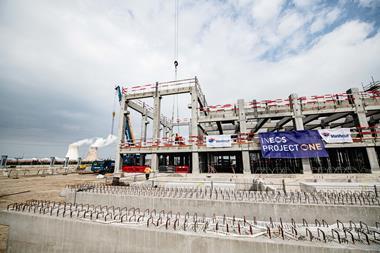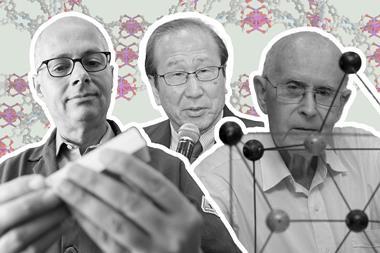Looking at how the chemical industry is reducing its energy consumption
Figures on the reduction of energy use in the European chemicals industry are impressive. A recent report by the European Chemical Industry Council (Cefic) shows an average annual 4.1% decrease in energy intensity (the energy consumption per unit of production) between 1990 and 2009, amounting to a total reduction of 54% over this 20 year period.
But in recent years, there has been a sharper focus on previously neglected aspects of energy wastage in chemicals production: the sometimes more complex and expensive areas which, if improved, would cut energy use beyond the usual economic demands of chemicals companies. Their elimination is less about productivity than climate protection.
These areas include everyday issues such as a liquid less homogeneous than supposed or a chemical reaction producing a different result under a given amount of pressure. They are often to be found in the interconnecting points where energy is converted from one spot to another. ‘Ensuring processes are well aligned provides a big potential for reducing energy use,’ says Maarten Neelis, a Dutch industrial energy efficiency specialist at environmental consultancy Ecofys.
Think big
Heat lost while powering a plant is a more obvious example of energy wastage. Some companies have tried to address this by investing in cogeneration plants: combined heat and power plants that generate both heat and steam. Cogeneration is used at BASF’s Verbund sites, including Ludwigshafen in Germany, Antwerp in Belgium, Nanjing in China and Geismar in the US.
The Verbund philosophy focuses on resource conservation; separate manufacturing plants on one huge site are linked together, and one plant’s by-product - such as heat - serves as a raw material for another. These plants have an overall fuel efficiency of 90%, according to Brigitte Achatz, who is responsible for global energy and waste management at BASF. This, she explains, yields an average efficiency of around 60% for the company when it’s 200 other (smaller) plants are included. But she says more needs to be done: ‘We want to increase energy efficiency by 25% in 2020 compared to 2002. We monitor every site but it’s getting harder because the low hanging fruit has been harvested,’ she says.
One option is to invest in more heat exchangers. Most companies use these in routine procedures such as solvent condensation or in heating columns. Elsewhere, such as in waste water cooling, they are optional, since there are other often cheaper ways to do so. As Achatz remarks: ‘Heat exchangers are expensive but you lose less heat. It’s a compromise between equipment size and energy use.’
There are always trade-offs relating to energy conservation. The obvious one is cost, but there are others including scale. ‘It’s not worth recovering heat at smaller sites,’ says Achatz. But it may also not be worth building a larger plant.
Another is the degree of distillation. ‘A higher reflux ratio will produce a very pure product. But is that always necessary?’ asks Achatz. A fourth is whether continuous or batch processing is used. ‘Continuous processes at large scale are the best,’ says Achatz. Finally, she points out the human factor. ‘Down times are the worst thing in terms of energy efficiency.’
A watchful eye
Like BASF, Bayer has been investigating tighter chemicals production. Among its innovations is a tool called STRUCTese. ‘We have developed and implemented a very innovative energy management system. This is the only system on the market with a clear link to the theoretical optimum,’ explains Johannes Eickmans, head of operational excellence at Bayer. First introduced in 2008, it will cover all major global production units, accounting for around 85% of the company’s global annual primary energy consumption (about 11TWh), once it has been fully rolled out in 2013.
The tool considers differences between the theoretical values of energy use (assuming year round production at the lowest possible energy consumption) and the actual energy use. These differences are classified into specific ‘loss codes’ such as alterations to the product mix, partial loads and down time. Remaining differences not falling into any of these categories are summarised as losses.
Eickmans explains: ‘These losses are caused by ambient temperatures or insulation deficiencies, heat tracing effects and other influences not accounted for within the model scope such as external cooling and pressurised air.’ One of the major benefits of the tool is a closer day-to-day awareness of what is going on in the factory; the factory operator monitors changes in energy use and is better able to understand their cause.
‘Managers can’t change [product mix] but can explain why present energy consumption is not equal to the operational energy optimum. Then they can influence this in a number of ways, for instance adjusting the reflux ratio, making sure all piping is correctly insulated or checking whether the steam traps are all working. These would all add up to undefined losses. The operator influence is the easiest to correct and doesn’t cost anything - it can save 10% of energy use,’ says Eickmans.
New technology
When considering chlorine and toluene diisocyanate (TDI), Bayer found energy consumption to be way off the theoretical energy optimum. For TDI, for instance, they found that the theoretical optimum is just 20-30% of the amount of energy currently being used. While for chlorine the equivalent figure is 65-75%.
Clearly, TDI is one of the more problematic petrochemicals. But there is only so much efficiency that can be gained by tweaks on the factory floor, and so the company is also improving the technology at its manufacturing plants. Bayer has recently invested in new TDI gas phase phosgenation technology that uses less energy and solvent. The first plant to use this technology - in Caojing in China - came on stream in 2011, and another is currently under construction in Dormagen, Germany, and due to start up in 2014.
A pilot plant for testing new technology for chlorine production was installed in Uerdingen, Germany, in 2011. The system, which includes an oxygen depolarised cathode (ODC), has now come on stream and if successful will reduce emissions and energy consumption.
‘These chemicals bear remarkable energy savings potential ready for realisation in the coming years. The emphasis is on laying on process innovations which have been proven on commercial scale at Bayer recently: the new ODC technology for chlorine production from HCl or NaCl saves 20-30% electricity against state-of-the-art electrolysis technology. New TDI gas phase technology is saving up to 60% primary energy in the TDI unit,’ points out Eickmans.
Improving selectivity
It is not entirely surprising that BASF and Bayer should be among the companies most concerned with energy efficiency; the petrochemicals industry, in which they play a major role, is very energy intensive.
In a 2007 paper on energy loss in the sector, Neelis and his coauthors showed that many of the processes it relies on are exothermic - energy is released during the reactions. Examples include the production of ammonia from natural gas and ethylene from naphtha.
They also identified two other reasons for energy loss; the first is non-selectivity, where some of the raw material is not converted to the desired products. This is caused either by the formation of undesired by-products or by the over-oxidation of the raw hydrocarbon. The second type of energy loss is the energy conversion loss that comes from the production of steam and electricity from primary energy carriers.
According to Neelis, developing processes with higher selectivity is a sure way to cut down on energy loss. Examples of relatively unselective processes include oxidation. His research shows improvements can be made; for instance the selectivity in ethylene oxide production has risen from around 70% in the 1960s to over 80%. Process intensification, in which separate reactions are combined in the same equipment, is another energy saving technique.
More work required
Neelis is rather sceptical of the chemical industry’s efforts to improve energy efficiency: ‘While it is not fair to say nothing has been done, it is true that there is a lot of remaining potential,’ he states, suggesting there is a lack of effort to join forces with industrial partners to improve synergies. ‘The chemicals industry is by nature quite conservative. There is, for instance, significant potential in the area of waste product use which is unexplored,’ he observes. One positive example is the port of Rotterdam in the Netherlands, which has a co-siting policy. This means industrial companies are making use of the waste products of their neighbours, such as heat or steam.
However, data on chemical consumption by the industry does show significant improvements. In addition to Cefic’s European report, another study by the International Council of Chemical Associations (ICCA) showed an annual cut of 3.6% in energy intensity in 1990-2005 worldwide.
Chemical companies are also interested in cutting down on energy use and emissions in the value chain through supply chain initiatives and innovative marketing. This includes AkzoNobel, which has an ‘eco-premium’ product range.
BASF takes a similar approach, claiming the use of its ‘climate protection products’ (including cement additives, lighter plastics and insulating materials) sold in 2011 will avoid a total of 330 million tonnes of greenhouse gas emissions, helping customers reduce their carbon footprint from around 1770 million tonnes to 1440 million tonnes.
Meanwhile, Solvay created an energy services business in 2012. ‘The idea is not only to help reduce our own energy use but to use our know-how for the benefit of external clients,’ says Solvay spokesman Erik De Leye.
Number confusion
But getting a holistic picture of energy consumption in the sector is difficult. To Martin Patel of Utrecht University in the Netherlands, an expert in energy and materials demand and efficiency in the chemicals sector, the reality of the industry’s performance is rather ambiguous. ‘It’s difficult to say whether energy efficiency improvements are going well or not,’ he remarks, ‘there are a lot of inconsistencies and weird patterns.’ This, he says, is partly due to measurements using different system boundaries in different countries and companies.
‘Energy statistics in the chemicals industry are complex and dramatically bad,’ he says. As an example, he points to chemicals datasets that do not count the energy consumed relating to feedstock but focus only on the energy used during the production process of the main chemical product.
Present policies in the chemicals sector are inadequate, he suggests: ‘Getting even a 2% increase in energy efficiency is physically very challenging - it cannot be done with present corporate and national policies,’ he states, alluding to the EU Emissions Trading System. However, Patel adds: ‘I do have hopes from corporate initiatives that have been taken recently, such as a new campaign called the Sustainability Consortium.’ An example, he suggests, showing that ‘energy management is being taken on board by senior management; it will remain a topic that won’t disappear’.
Elisabeth Jeffries is a science writer based in London, UK
References
- M Neelis et al, Energy, 2007, 32, 1104 (DOI: 10.1016/j.energy.2006.08.005)












No comments yet